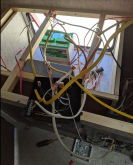Not entirely, but let me take a crack at it:@beckkl please acknowledge that you understand the significance of the neutral/ground bond and how its relates to mobile applications with shore power.
I think there was an outstanding question as to whether the MPP will switch the neutral bond if on shore power vs not, correct? As in the neutral would be bonded to the chassis when on battery, but not if on shore power. Is the idea that if I had an ATS I could bond the NC inverter input neutral to the chassis?





